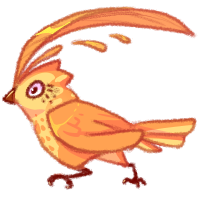Description
These birds caused the myth of phoenixes to be born. While, yes, their diet of phoenix grass has given their plumage similar, fire-resistant properties, there is no such thing as a real phoenix. There are only fantasies passed down through generations. Now that the distinction between fact and fiction has been made, we can discuss the matter at hand: how grain quails are used.
Grain quails are one of the less popular farm fowl due to the simple fact that neither their meat nor their eggs cook thoroughly. The grass that makes up their diet has an essential nutrient in it that the birds require to survive, so although a domestic grain quail could theoretically be raised without the phoenix grass, they wouldn't grow to be anywhere near as happy or healthy as their phoenix-grass-fed partners. This means that all grain quail products resist heat. Grain quail eggs are primarily found in dishes that require the eggs to be raw (the meals typically featuring rice or noodles) whereas their meat is used to feed animals capable of digesting raw poultry.
Now a grain quail's plumage is an entirely different story. Their fire-resistant properties result in a coveted down for blankets and pillows, while grain quails' signature cere-feathers can be sold for a decent opal at shops, designers adoring the sheen it gives hats, pocket squares, and feather boas. The only issue is that gathering strictly shed feathers cannot keep up with demand. Very few articles that use the down are vegan.
Availability
Explorations
Potentially Found While Exploring:

